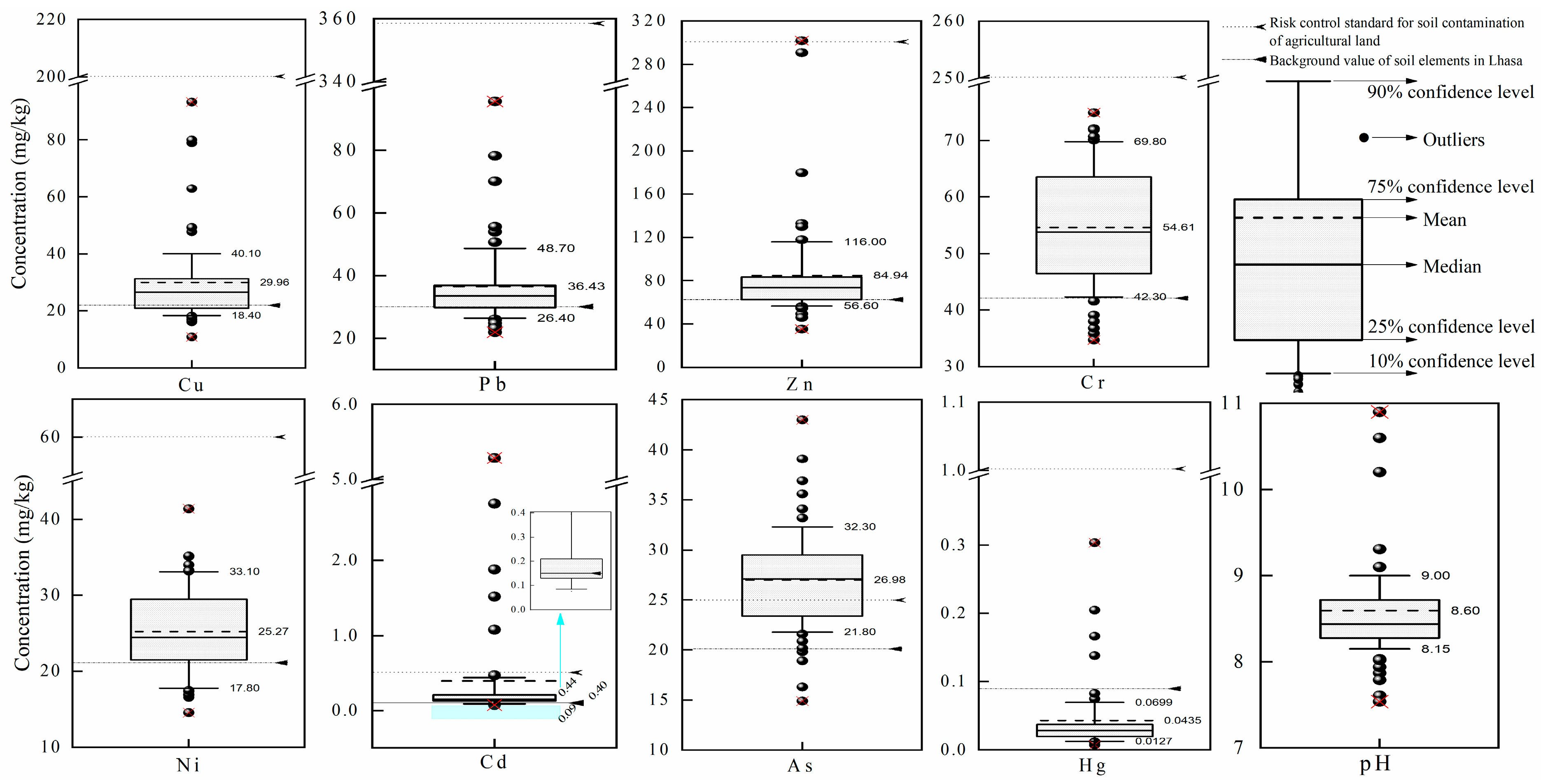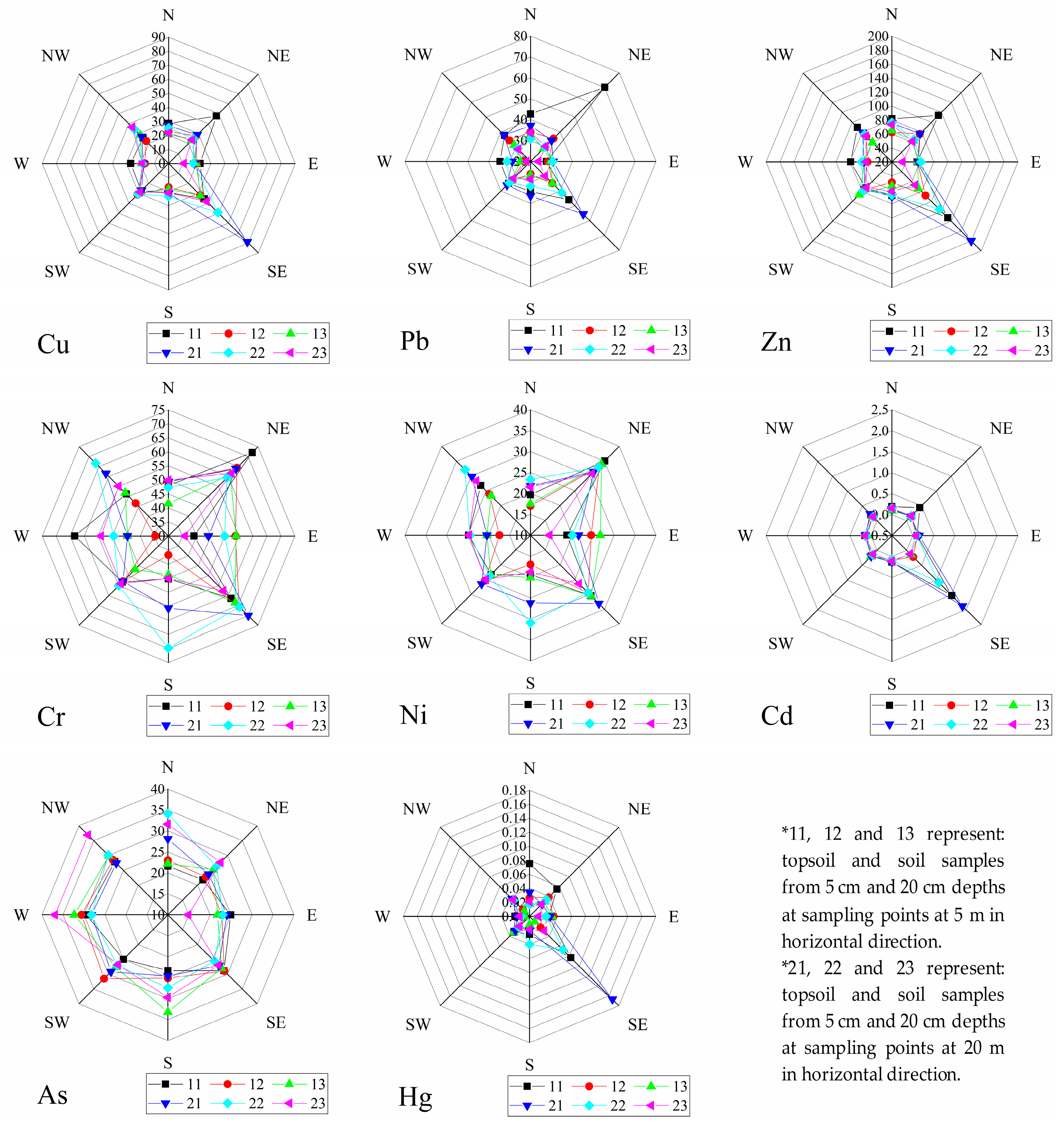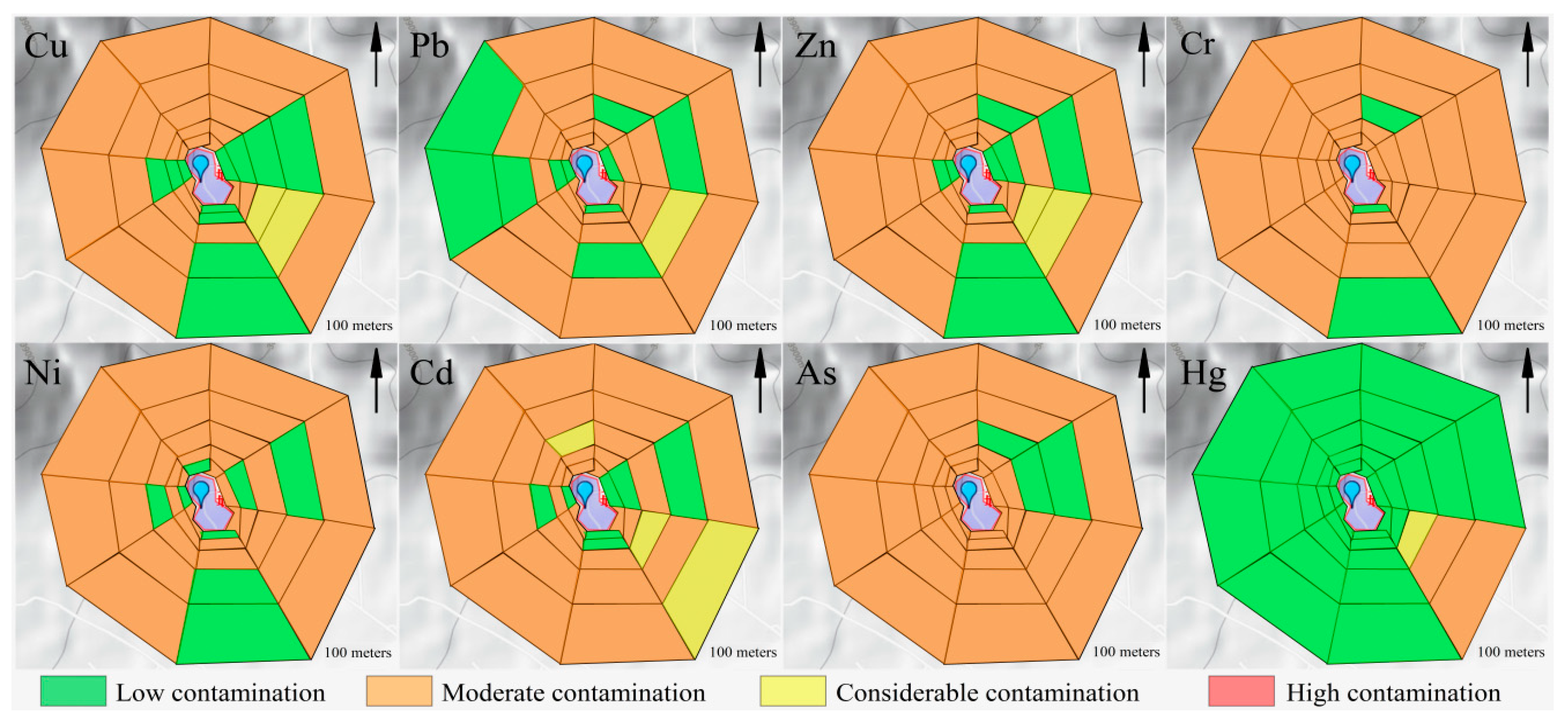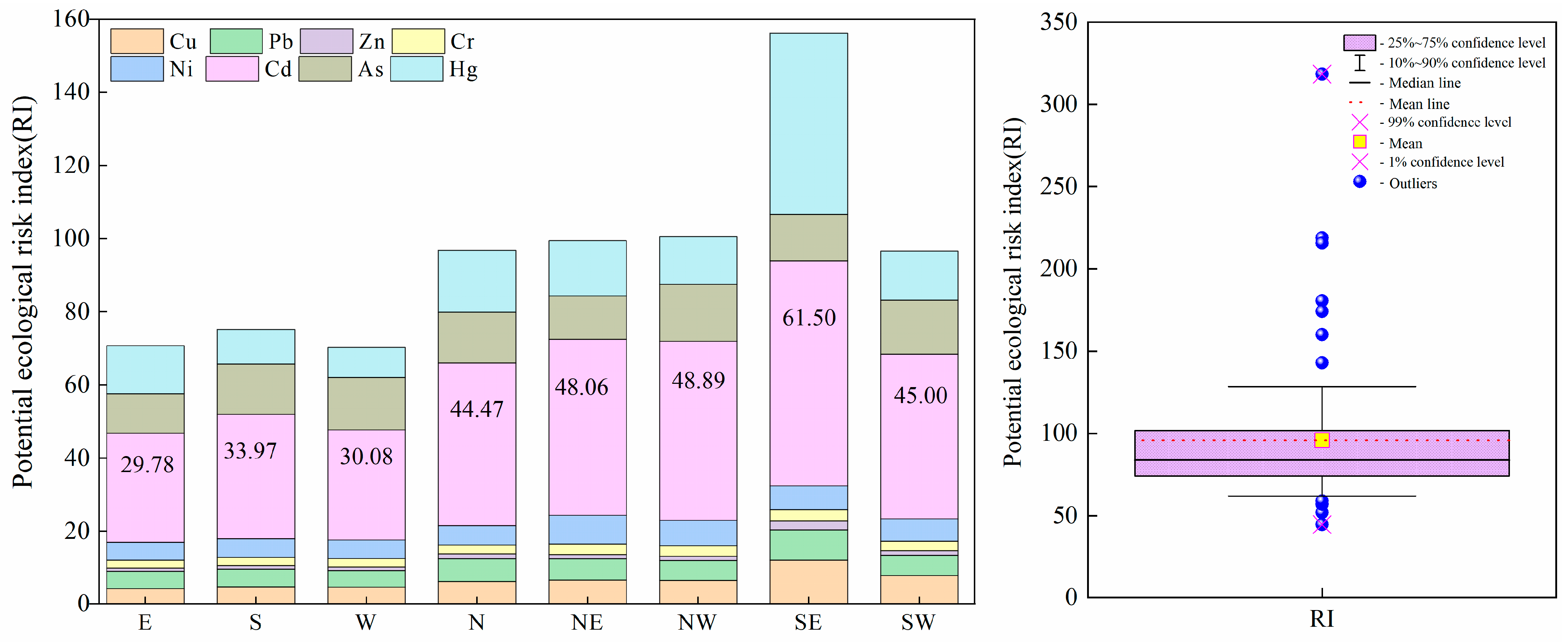Pollution Levels and Risk Assessment of Heavy Metals in the Soil of a Landfill Site: A Case Study in Lhasa, Tibet
Abstract
:1. Introduction
2. Materials and Methods
2.1. Study Area
2.2. Sampling and Chemical Analysis
2.3. Contamination Assessment Methods
2.4. Ecological Risks of Soil Heavy Metal
2.5. Health Risk of Heavy Metals
2.6. Source Apportionment of Soil Heavy Metals
3. Results and Discussion
3.1. Soil Properties and Heavy Metal Concentrations
3.2. Soil Heavy Metal Contamination Risk
3.3. Soil Ecological Risk
3.4. Health Risk Assessment of Soil Heavy Metals
3.4.1. Carcinogenic Risk
3.4.2. Non-Carcinogenic Risk
3.5. Possible Sources of Soil Heavy Metals
4. Conclusions
Supplementary Materials
Author Contributions
Funding
Institutional Review Board Statement
Informed Consent Statement
Data Availability Statement
Acknowledgments
Conflicts of Interest
References
- Wei, X.X.; Wang, X.M.; Li, L.; Liu, C.; Stanisavljevic, N.; Peng, X. Temporal and spatial characteristics of municipal solid waste generation and treatment in China from 1979 to 2016. China Environ. Sci. 2018, 38, 3833–3843. [Google Scholar]
- Li, Y.Q. Research on urban garbage disposal in China. J. Shaanxi Norm. Univ. (Nat. Sci. Ed.) 2004, 2, 112–116. [Google Scholar]
- Wang, J.H.; Jiang, X.J.; Wu, Y.L. Summary of the status of MSW disposal. Henan Build. Mater. 2016, 6, 61–62. [Google Scholar]
- Xu, H.Y. A review of the development of the MSW treatment industry in 2017. China Environ. Prot. Ind. 2018, 7, 5–9. [Google Scholar]
- Zhao, P.P. Domestic Waste Disposal in Small Towns—Based on the Research of Shenqiu Town in Henan Province; Lanzhou University: Lanzhou, China, 2011. [Google Scholar]
- Zhang, Y.H. Discussion on Domestic Rubbish Disposal Technology. China Resour. Compr. Util. 2018, 36, 55–57. [Google Scholar]
- Emami, S.; Negahdar, A.; Zarei, M. Investigating the Influence of the Leachate from the MSW on the Mechanical and Environmental Properties of Soil around the Landfill (Case Study: The Municipal Landfill Located in Ardabil—Iran). Arab. J. Sci. Eng. 2019, 44, 8417–8428. [Google Scholar] [CrossRef]
- Ye, J.S.; Chen, X.; Chen, C.; Bate, B. Emerging sustainable technologies for remediation of soils and groundwater in an MSW landfill site—A review. Chemosphere 2019, 227, 681–702. [Google Scholar] [CrossRef]
- Shimbo, S.; Zhang, Z.W.; Watanabe, T.; Nakatsuka, H.; Matsuda-Inoguchi, N.; Higashikawa, K.; Ikeda, M. Cd and Zn contents in rice and other cereal products in Japan in 1998–2000. Sci. Total Environ. 2001, 281, 165–170. [Google Scholar] [CrossRef]
- Balsher, S.S.; Dikshant, S.; Tushar, T.; Gupta, S.; Kumar, A. Human Health Risk Assessment of Heavy Metals from Bhalaswa Landfill, New Delhi, India. In Management of Natural Resources in a Changing Environment; Raju, N., Gossel, W., Sudhakar, M., Eds.; Springer: Cham, Switzerland, 2015; pp. 215–223. [Google Scholar]
- Osei, A.; Collins, N.; Joseph, A.; Bailey, D.; Bortey-Sam, N. Spatial distribution, exposure, and health risk assessment of bioavailable forms of heavy metals in surface soils from abandoned landfill sites in Kumasi, Ghana. Hum. Ecol. Risk Assess. Int. J. 2018, 25, 1870–1885. [Google Scholar]
- Wu, J.; Lu, J.; Li, L.; Min, X.; Luo, Y. Pollution, ecological-health risks, and sources of heavy metals in the soil of the northeastern Qinghai-Tibet Plateau. Chemosphere 2018, 201, 234–242. [Google Scholar] [CrossRef]
- Han, Z.Y.; Xu, M.; Liu, G. Pollutant identification and quality assessment of groundwater near municipal solid waste landfills in China. China Environ. Sci. 2015, 35, 2843–2852. [Google Scholar]
- Wang, S.; Han, Z.; Wang, J.; He, X.; Zhou, Z.; Hu, X. Environmental risk assessment and factors influencing heavy metal concentrations in the soil of municipal solid waste landfills. Waste Manag. 2022, 139, 330–340. [Google Scholar] [CrossRef]
- Wu, J.; Lu, J.; Li, L.; Min, X.; Zhang, Z.; Luo, Y. Distribution, pollution, and ecological risks of rare earth elements in soil of the northeastern Qinghai-Tibet Plateau. Hum. Ecol. Risk Assess. 2019, 25, 1816–1831. [Google Scholar] [CrossRef]
- Cheng, H.; Li, K.; Li, M.; Yang, K.; Liu, F.; Cheng, X. Geo-chemical background and baseline value of chemical elements in urban soil in China. Earth Sci. Front. 2014, 21, 265–306. [Google Scholar]
- Tomlinson, D.L.; Wilson, J.G.; Harris, C.R.; Jeffrey, D.W. Problems in the assessment of heavy-metal levels in estuaries and the formation of a pollution index. Helgol. Mar. Res. 1980, 33, 566–575. [Google Scholar] [CrossRef]
- Huang, Y.; Chen, Q.; Deng, M.; Japenga, J.; Li, T.; Yang, X.; He, Z. Heavy metal pollution and health risk assessment of agricultural soils in a typical peri-urban area in southeast China. J. Environ. Manag. 2018, 207, 159–168. [Google Scholar] [CrossRef]
- Martínez-Guijarro, R.; Paches, M.; Romero, I.; Aguado, D. Enrichment and contamination level of trace metals in the Mediterranean marine sediments of Spain. Sci. Total Environ. 2019, 693, 133566. [Google Scholar] [CrossRef]
- Wu, J.; Duan, D.; Lu, J.; Luo, Y.; Wen, X.; Guo, X.; Boman, B.J. Inorganic pollution around the Qinghai-Tibet Plateau: An overview of the current observations. Sci. Total Environ. 2016, 550, 628–636. [Google Scholar] [CrossRef] [PubMed]
- Memoli, V.; Esposito, F.; Panico, S.C.; De Marco, A.; Barile, R.; Maisto, G. Evaluation of tourism impact on soil metal accumulation through single and integrated indices. Sci. Total Environ. 2019, 682, 685–691. [Google Scholar] [CrossRef]
- Müller, G. Index of Geoaccumulation in Sediments of the Rhine River. Geo J. 1969, 2, 108–118. [Google Scholar]
- Xu, D.; Gao, B.; Chen, S.; Peng, W.; Zhang, M.; Qu, X.; Gao, L.; Li, Y. Release risk assessment of trace metals in urban soils using in-situ DGT and DIFS model. Sci. Total Environ. 2019, 693, 133624. [Google Scholar] [CrossRef] [PubMed]
- Håkanson, L. An ecological risk index for aquatic pollution control. A sedimentological approach. Water Res. 1980, 14, 975–1001. [Google Scholar] [CrossRef]
- Ke, X.; Gui, S.; Huang, H.; Zhang, H.; Wang, C.; Guo, W. Ecological risk assessment and source identification for heavy metals in surface sediment from the Liaohe River protected area, China. Chemosphere 2017, 75, 473–481. [Google Scholar] [CrossRef] [PubMed]
- Han, Z.; Guo, X.; Zhou, Y.; Shao, J.; Deng, C.; Wang, L.; Wang, C. Soil quality assessment of Beijing Heishitou Landfill in the latetreatment period. Chin. J. Environ. Eng. 2016, 10, 5319–5325. [Google Scholar]
- Ministry of Ecology and Environment of the people Republic of China. Technical Guidelines for Risk Assessment of Contaminated Sites; Environmental Press: Beijing, China, 2014. [Google Scholar]
- USEPA. Exposure Factors Handbook: Volume I. General Factors; EPA/600/P-59/002 Fa; US Environmental Protection Agency: Washington, DC, USA, 1997.
- Grzetic, I.; Ghariani, A. Potential health risk assessment for soil heavy metal contamination in the central zone of Belgrade (Serbia). J. Serb. Chem. Soc. 2008, 73, 923–934. [Google Scholar] [CrossRef]
- Lu, X.; Wang, L.; Li, L.Y.; Lei, K.; Huang, L.; Kang, D. Multivariate statistical analysis of heavy metals in street dust of Baoji, NW China. J. Hazard. Mater. 2010, 173, 744–749. [Google Scholar] [CrossRef]
- Li, X.; Feng, L. Multivariate and geostatistical analyzes of metals in urban soil of Weinan industrial areas, Northwest of China. Atmos. Environ. 2012, 47, 58–65. [Google Scholar] [CrossRef]
- Luo, X.-S.; Xue, Y.; Wang, Y.-L.; Cang, L.; Xu, B.; Ding, J. Source identification and apportionment of heavy metals in urban soil profiles. Chemosphere 2015, 127, 152–157. [Google Scholar] [CrossRef]
- Zhang, Y.; Zhang, H.W.; Su, Z.C.; Zhang, C.G. Effect of sewage irrigation on the distribution of heavy metal, enzyme activities and microbial population in the soi. J. Saf. Environ. 2006, 6, 44–50. [Google Scholar]
- Zhong, G.J.; Shen, Y.; Zhou, F.R. Study on the characteristics and countermeasures of heavy metal pollution in municipal solid waste landfill sites in Tibet high altitude area. Environ. Dev. 2018, 6, 58–60. [Google Scholar]
- Xie, W.B.; Zhang, H.G.; Wen, Z.H. Investigation of heavy metal contamination of soil at a landfill in Guangzhou. In Proceedings of the 2nd Advanced Workshop on Risk Assessment of Heavy Metal Pollution Monitoring and Remediation Technology, Urumqi, China, 26 July 2008; Chinese Society for Environmental Sciences: Beijing, China, 2008; pp. 161–166. [Google Scholar]
- Liang, J.; Wang, X.G.; Zhang, Q.F.; Fang, H.L.; Zheng, S.J.; Hao, G.J. A study on soil characteristics of municipal rubbish landfill in Shanghai. J. Nanjing For. Univ. (Nat. Sci. Ed.) 2013, 37, 147–152. [Google Scholar]
- Luo, X.Q.; Que, D.D.; Zhang, G.L. Evaluation of Soil Heavy Metal Pollution in Gaoyan Urban Domestic Garbage Sanitary Landfill Site of Guiyang City. J. Mt. Agric. Biol. 2013, 32, 159–163. [Google Scholar]
- Wang, H.Z.; Du, R.Z. Analysis of Heavy Metal Pollution in the Soil Around a Municipal Solid Waste Landfill. Shandong Chem. Ind. 2016, 45, 157–158+161. [Google Scholar]
- Dai, L.; Wang, L.; Liang, T.; Zhang, Y.; Li, J.; Xiao, J.; Dong, L.; Zhang, H. Geostatistical analyses and co-occurrence correlations of heavy metals distribution with various types of land use within a watershed in eastern QingHai-Tibet Plateau, China. Sci. Total Environ. 2019, 653, 849–859. [Google Scholar] [CrossRef] [PubMed]
- Dan, Z.; Bu, D. Analysis on physical Characteristics of domestic waste in the urban areas in Lhasa. J. Tibet Univ. 2012, 27, 20–27. [Google Scholar]
- Geng, Q.; Wang, H.; Wang, J.; Hong, J.; Sun, W.; Wu, Y.; Wang, Y. Boosting the Capacity of Aqueous Li-Ion Capacitors via Pinpoint Surgery in Nanocoral-Like Covalent Organic Frameworks. Small Methods 2022, 6, e2200314. [Google Scholar] [CrossRef]
- Quina, M.J.; Bordado, J.M.; Quinta-Ferreira, R.M. Recycling of air pollution control residues from municipal solid waste incineration into lightweight aggregates. Waste Manag. 2014, 34, 430–438. [Google Scholar] [CrossRef]
- Tian, C.; Gupta, R.; Zhao, Y.; Zhang, J. Release Behaviors of Arsenic in Fine Particles Generated from a Typical High-Arsenic Coal at a High Temperature. Energy Fuels 2016, 30, 6201–6209. [Google Scholar] [CrossRef]
- Chen, H.M.; Zheng, C.R.; Zhou, D.M. Some issues of concern in research on soil environmental protection in China. J. Agro-Environ. Sci. 2004, 23, 1244–1245. [Google Scholar]
- Qiongda, Z.M.; Wang, J.; Zhou, W.W. Analysis and evaluation of heavy metal content in soil around leachate treatment station of lhasa landfill site. Environ. Chem. 2020, 39, 1404–1409. [Google Scholar]
- Tai, L.Y. Contamination Source Apportionment and Health Risk Assessment of Heavy Metals in Soil Around Waste to Energy Plant; Tianjin University: Tianjin, China, 2018. [Google Scholar]
- USEPA. Risk assessment Guidance for Superfund. In Human Health Evaluation Manual; EPA/540/1-89/002; Office of Solid Waste and Emergency: Washington, DC, USA, 1989. [Google Scholar]
- Wang, X.; Wang, F.; Chen, B.; Sun, F.; He, W.; Wen, D.; Liu, X.; Wang, Q. Comparing the health risk of toxic metals through vegetable consumption between industrial polluted and non-polluted fields in Shaoguan, south China. J. Food Agric. Environ. 2012, 10, 943–948. [Google Scholar]
- Zhu, G.; Guo, Q.; Xiao, H.; Chen, T.; Yang, J. Multivariate statistical and lead isotopic analyses approach to identify heavy metal sources in topsoil from the industrial zone of Beijing Capital Iron and Steel Factory. Environ. Sci. Pollut. Res. 2017, 24, 14877–14888. [Google Scholar] [CrossRef] [PubMed]
- Ma, Z.; Chen, K.; Li, Z.; Bi, J.; Huang, L. Heavy metals in soils and road dusts in the mining areas of Western Suzhou, China: A preliminary identification of contaminated sites. J. Soils Sediments 2016, 16, 204–214. [Google Scholar] [CrossRef]
- Ma, W.; Tai, L.; Qiao, Z.; Zhong, L.; Wang, Z.; Fu, K.; Chen, G. Contamination source apportionment and health risk assessment of heavy metals in soil around municipal solid waste incinerator: A case study in North China. Sci. Total Environ. 2018, 631–632, 348–357. [Google Scholar] [CrossRef] [PubMed]







| Cu | Pb | Zn | Cr | Ni | Cd | As | Hg | PH | |
|---|---|---|---|---|---|---|---|---|---|
| Arithmetic mean | 29.96 | 36.43 | 84.94 | 54.61 | 25.27 | 0.40 | 26.98 | 0.04 | 8.60 |
| Standard deviation | 16.10 | 13.71 | 49.49 | 10.42 | 5.57 | 0.92 | 4.89 | 0.05 | 0.64 |
| Coefficient of variance | 0.54 | 0.38 | 0.58 | 0.19 | 0.22 | 2.33 | 0.18 | 1.26 | 0.07 |
| Skewness | 2.61 | 2.90 | 3.50 | 0.10 | 0.34 | 4.57 | 0.49 | 3.63 | 2.19 |
| Kurtosis | 7.20 | 9.46 | 12.87 | −0.82 | −0.34 | 21.50 | 1.34 | 14.02 | 5.65 |
| Guangzhou [35] | Null | 31.6 | 60.1 | 77.1 | 20.5 | 0.072 | Null | 0.091 | Null |
| Shanghai [36] | 68.1 | 94.5 | 1437.8 | 69.9 | 34.1 | 4.57 | 356.7 | 0.043 | Null |
| Guiyang [37] | Null | 49.72 | 1025.4 | Null | 122.96 | 13.67 | Null | Null | Null |
| Shandong [38] | 128.48 | 333.34 | 301.95 | 108.86 | 30.23 | 0.64 | 18.2 | 0.045 | Null |
| Background value of soil elements in Lhasa City [16] | 22.00 | 31.00 | 65.00 | 42.00 | 21.00 | 0.12 | 20.00 | 0.092 | 8.20 |
| Chinese soil guidelines (Grade II) (CEPA, 1995) | 200.00 | 350.00 | 300.00 | 250.00 | 60.00 | 0.60 | 25.00 | 1.00 | Null |
| Carcinogenic Risk | CRingest | CRdermal | CRinhale | CR | ||||||
|---|---|---|---|---|---|---|---|---|---|---|
| Avg | Max | Min | Avg | Max | Min | Avg | Max | Min | ||
| Cd | 9.13 × 10−7 | 1.47 × 10−5 | 2.12 × 10−7 | 1.18 × 10−10 | 1.90 × 10−9 | 2.73 × 10−11 | 1.14 × 10−8 | 1.85 × 10−7 | 2.65 × 10−9 | 9.25 × 10−7 |
| Contribution | 98.67% | 0.09% | 1.24% | - | ||||||
| As | 1.50 × 10−5 | 2.39 × 10−5 | 8.31 × 10−6 | 1.45 × 10−9 | 2.32 × 10−9 | 8.04 × 10−10 | 2.25 × 10−6 | 3.59 × 10−6 | 1.24 × 10−6 | 1.73 × 10−5 |
| Contribution | 86.84% | 0.17% | 12.99% | - | ||||||
| Non-Carcinogenic Risk | HQingest | HQinhale | HQdermal | HI | ||||||
|---|---|---|---|---|---|---|---|---|---|---|
| Max | Min | Avg | Max | Min | Avg | Max | Min | Avg | ||
| Cu | 1.25 × 10−2 | 1.46 × 10−3 | 3.89 × 10−3 | 6.51 × 10−2 | 7.60 × 10−3 | 2.03 × 10−2 | 4.03 × 10−5 | 4.71 × 10−6 | 1.26 × 10−5 | 2.42 × 10−2 |
| Pb | 1.46 × 10−1 | 3.35 × 10−2 | 5.44 × 10−2 | 1.80 × 10−3 | 4.20 × 10−4 | 6.80 × 10−4 | 4.70 × 10−4 | 1.10 × 10−4 | 1.80 × 10−4 | 5.53 × 10−2 |
| Zn | 5.39 × 10−3 | 6.30 × 10−4 | 1.46 × 10−3 | 6.75 × 10−5 | 7.88 × 10−6 | 1.83 × 10−5 | 1.74 × 10−5 | 2.03 × 10−6 | 4.72 × 10−6 | 1.48 × 10−3 |
| Cr | 1.34 × 10−1 | 6.19 × 10−2 | 9.69 × 10−2 | 2.09 × 10−1 | 9.69 × 10−2 | 1.52 × 10−1 | 1.73 × 10−2 | 7.90 × 10−3 | 1.25 × 10−2 | 2.61 × 10−1 |
| Ni | 1.11 × 10−2 | 3.91 × 10−3 | 6.73 × 10−3 | 1.29 × 10−1 | 4.53 × 10−2 | 7.81 × 10−2 | 8.90 × 10−4 | 3.20 × 10−4 | 5.40 × 10−4 | 8.54 × 10−2 |
| Cd | 2.83 × 10−2 | 4.07 × 10−4 | 1.75 × 10−3 | 1.48 × 10−1 | 2.12 × 10−3 | 9.20 × 10−3 | 3.66 × 10−6 | 5.25 × 10−8 | 2.26 × 10−7 | 1.10 × 10−2 |
| As | 7.67 × 10−1 | 2.66 × 10−1 | 4.81 × 10−1 | 8.01 × 10−1 | 2.77 × 10−1 | 5.02 × 10−1 | 7.43 × 10−5 | 2.57 × 10−5 | 4.66 × 10−5 | 9.83 × 10−1 |
| Hg | 5.42 × 10−3 | 1.30 × 10−4 | 7.11 × 10−4 | 2.80 × 10−4 | 6.79 × 10−6 | 3.71 × 10−5 | 2.50 × 10−4 | 6.01 × 10−6 | 3.28 × 10−5 | 7.81 × 10−4 |
| Contribution | 51.75% | 46.94% | 1.31% | - | ||||||
| Heavy Metals | Cu | Pb | Zn | Cr | Ni | Cd | As | Hg |
|---|---|---|---|---|---|---|---|---|
| Cu | 1.000 | |||||||
| Pb | 0.933 ** | 1.000 | ||||||
| Zn | 0.958 ** | 0.955 ** | 1.000 | |||||
| Cr | 0.812 * | 0.758 * | 0.705 | 1.000 | ||||
| Ni | 0.497 | 0.423 | 0.332 | 0.899 ** | 1.000 | |||
| Cd | 0.901 ** | 0.894 ** | 0.974 ** | 0.634 | 0.263 | 1.000 | ||
| As | 0.038 | −0.095 | −0.033 | 0.049 | 0.031 | −0.169 | 1.000 | |
| Hg | 0.906 ** | 0.936 ** | 0.975 ** | 0.632 | 0.252 | 0.982 ** | −0.211 | 1.000 |
| Factors | Cu | Pb | Zn | Cr | Ni | Cd | As | Hg | % of Variance | Cumulative % |
|---|---|---|---|---|---|---|---|---|---|---|
| PC1 | 0.89 | 0.88 | 0.97 | 0.39 | 0.02 | 0.94 | −0.11 | 0.95 | 55.52 | 55.52 |
| PC2 | 0.31 | 0.26 | 0.16 | 0.88 | 0.96 | 0.01 | 0.12 | 0.07 | 23.72 | 79.24 |
| PC3 | 0.11 | −0.14 | −0.05 | 0.05 | 0.1 | −0.1 | 0.98 | −0.11 | 12.98 | 92.22 |
Publisher’s Note: MDPI stays neutral with regard to jurisdictional claims in published maps and institutional affiliations. |
© 2022 by the authors. Licensee MDPI, Basel, Switzerland. This article is an open access article distributed under the terms and conditions of the Creative Commons Attribution (CC BY) license (https://creativecommons.org/licenses/by/4.0/).
Share and Cite
Zhou, P.; Zeng, D.; Wang, X.; Tai, L.; Zhou, W.; Zhuoma, Q.; Lin, F. Pollution Levels and Risk Assessment of Heavy Metals in the Soil of a Landfill Site: A Case Study in Lhasa, Tibet. Int. J. Environ. Res. Public Health 2022, 19, 10704. https://doi.org/10.3390/ijerph191710704
Zhou P, Zeng D, Wang X, Tai L, Zhou W, Zhuoma Q, Lin F. Pollution Levels and Risk Assessment of Heavy Metals in the Soil of a Landfill Site: A Case Study in Lhasa, Tibet. International Journal of Environmental Research and Public Health. 2022; 19(17):10704. https://doi.org/10.3390/ijerph191710704
Chicago/Turabian StyleZhou, Peng, Dan Zeng, Xutong Wang, Lingyu Tai, Wenwu Zhou, Qiongda Zhuoma, and Fawei Lin. 2022. "Pollution Levels and Risk Assessment of Heavy Metals in the Soil of a Landfill Site: A Case Study in Lhasa, Tibet" International Journal of Environmental Research and Public Health 19, no. 17: 10704. https://doi.org/10.3390/ijerph191710704





